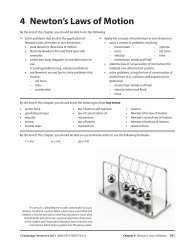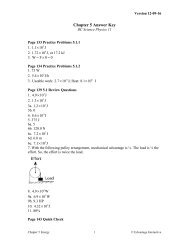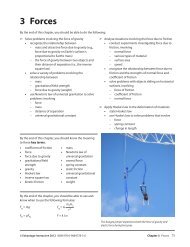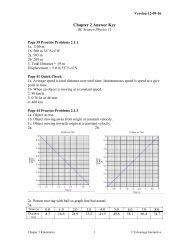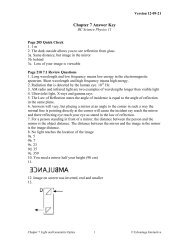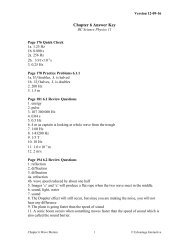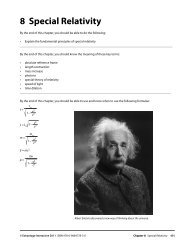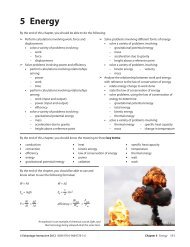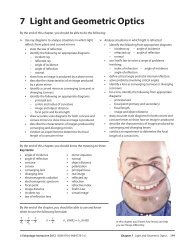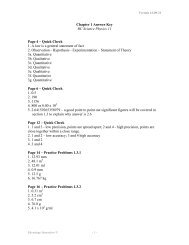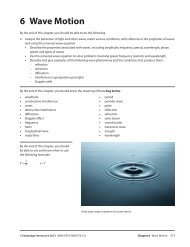2 Kinematics - BC Science Physics 11
2 Kinematics - BC Science Physics 11
2 Kinematics - BC Science Physics 11
You also want an ePaper? Increase the reach of your titles
YUMPU automatically turns print PDFs into web optimized ePapers that Google loves.
2.4 Review Questions<br />
1. On a certain asteroid, a steel ball drops a distance<br />
of 0.80 m in 2.00 s from rest. Assuming uniform<br />
acceleration due to gravity on this asteroid, what is<br />
the value of g on the asteroid?<br />
2. The graph below represents the velocity of a ball<br />
thrown straight up by a strong pitcher as a function<br />
of time. In the first part of the graph ending at<br />
A, the ball is accelerated to 39.2 m/s in a time of<br />
0.20 s. After the ball leaves the pitcher’s hand, it<br />
experiences only the acceleration due to gravity<br />
until it is caught in a glove and brought to rest in the<br />
hand of the catcher.<br />
�����������������<br />
�����������������������������������������������<br />
�������������������<br />
��<br />
��<br />
��<br />
��<br />
�����������������<br />
�<br />
����<br />
���<br />
���<br />
���<br />
����������������������<br />
� �� ���� ���� ���� ���� ���� ���� ���� ���� ���� ����<br />
�����������<br />
�����������������<br />
(a) What is the acceleration of the ball while it is<br />
being thrown?<br />
(b) What is the acceleration of the ball after it leaves<br />
the pitcher’s hand? (A<strong>BC</strong>)<br />
(c) What is the acceleration of the ball while it is<br />
being caught? (CD)<br />
(d) What point on the graph (A, B, C, or D)<br />
corresponds with the instant when the ball is at<br />
the peak of its flight? Explain your answer.<br />
(e) Why is the slope of the graph negative as soon<br />
as the ball leaves the pitcher’s hand?<br />
(f) Why is the graph labelled velocity rather than<br />
speed?<br />
(g) How far up did the ball travel?<br />
(h) How far down did the ball fall?<br />
(i) What is the average velocity of the ball for the<br />
whole trip from pitcher’s hand to catcher’s<br />
hand?<br />
3. A body in free fall accelerates at a rate of 9.81 m/s 2 at<br />
your latitude. How far does the body fall during<br />
(a) the first second? (b) the second second? (Think<br />
first!)<br />
68 Chapter 2 <strong>Kinematics</strong> © Edvantage Interactive 2012 ISBN 978-0-9864778-3-6



